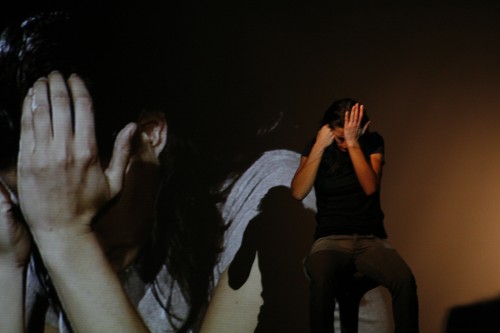
Above: Torn Space's production of Area (2008). Photo: Lukia Costello.
Over the last couple of decades, we have seen the emergence of a theatre that seeks to go "beyond drama." This post-dramatic theatre is out to re-think every traditional aspect of the art-form. It takes all that theatre has traditionally privileged—story, plot, character—and decenters it.
Modernist theatre, it might be argued, also proceeds in this manner. But post-dramatic theatre (sometimes loosely referred to as "postmodern theatre") pushes this de-emphasis of narrative to an extreme. Even the "text" of the work—that part of the work that we assume to exist prior to performance—is de-privileged. Instead, what comes to the fore are the primal but traditionally repressed elements of theatre: bodies, objects, movement, rhythm, light and space.
There lies an important link between post-dramatic theatre and experimental (or avant-garde) cinema. Both often focus on aspects of an art-work that are primal, pre-narrative, in that these aspects often exist before the “secondary elaboration” of narrative makes its appearance. In fact, a hallmark of this form of theatre is its permeability to powerful influences from other art-forms, primarily cinema (it's also sometimes known as "image-based theatre") but also painting, dance, and sculpture.
The number of theatre companies in North America who have devoted themselves to this paradigm—and done so in a sustained spirit of exploration over the long haul—is small. Among them is Buffalo-based Torn Space, founded and run by Dan Shanahan and Melissa Meola. The latest of the company's twenty-plus productions is the mesmerizing Area (2008).
In it, a character (Girl 1, played by Kara Gabrielle McKenney) enters a non-naturalistic space difficult to identify as something recognizable, e.g. as a living or working space. She moves slowly through it as if in a trance, but with great deliberation. Seemingly regulated by some invisible itinerary, she stops to perform everyday tasks, like frying an egg, with exaggerated solemnity. Her every move and action seem like they're part of some elaborate ceremony.
The hush of the ritual is broken by an offscreen agent-voice (Melissa Meola) that leads Girl 1 slowly through memories of acts she may or may not have committed. A TV screen, previously inert, springs to life with images of Girl 2 (Rebecca Globus) enacting these memories with the aid of spoken "found text," like passages from a Raymond Carver story. This forms the slender but mysterious narrative of the production.

Above: Torn Space's production of The Architect (2007). Lukia Costello.
One way to think about Area and post-dramatic theatre is to envision any theatrical performance as unfolding in relation to two axes: the x (horizontal) and y (vertical). Time occupies the x-axis, and narrative incidents propel a piece along this direction. But Area frequently suspends movement along the x to instead focus on tableaux-like scenes which activate the y-axis. What results is a theatre of states, in which the weight of narrative movement and expectation is lifted, redirecting the audience's attention to the physicality and movement of bodies, to the plasticity of decors, to the sculpting of space—all of which are only very loosely connected to narrative exigencies.
Robert Wilson is a crucial influence on post-dramatic theatre. He refers to the "scenography" of his works being counterparts to the "choreography" of dance pieces. Area is constructed using such a scenographic notion. What's more, these scenes are not particularly interested in building a dramatic unity within or across scenes.
Hans-Thies Lehmann, probably the best-known theorist of post-dramatic theatre, believes that the traditional model of "drama" strongly values the objectives of "wholeness, illusion, and world representation." If this is the case, what takes the place of wholeness and unity in post-dramatic theatre? Robert Wilson's comments about his video work are helpful:
"In many of my pieces, what you see and what you hear do not go together. The video and audio are meant to stand on their own. If you closed your eyes you would still be able to appreciate the program, and the same would be true if you turned off the sound and just looked. What I am trying to do is give individual lives to both sound and picture."
Rather than tying disparate elements of the production into a whole that serves narrative or character, this new theatre forces a new way of seeing and hearing that focuses our attention on fragments as autonomous entities of matter or time.
This new approach to perceiving and experiencing theatre also applies to perhaps the first thing we think of when we think of this art-form: words. Words here are deflected away from functional purposes, and deployed in ways that highlight their material qualities; sonorities; texture and tone; the rhythmic effects of their repetitions and juxtapositions; their mythic resonances and associations; their trance-like, mesmeric qualities; and their slippages of signification.
But nevertheless, if Area—and post-dramatic theatre in general—harbors any form of unity, it has to do with the cohesive aesthetic system that often unfolds in the oeuvre of an artist over time. According to Romeo Castellucci, one of the luminaries of avant-garde drama, the artist Matthew Barney offers an illustrative model of such a self-contained language, a powerful collection of signs that refer to reality but nevertheless construct a new and visionary system. It is just such an edifice—an original, personal, rich and internally resonant system—that we find good post-dramatic theatre artists like Torn Space engaged in constructing and elaborating with each new production.

Above: Torn Space's production of Terminus (2006). Photo: Aaron Miller.